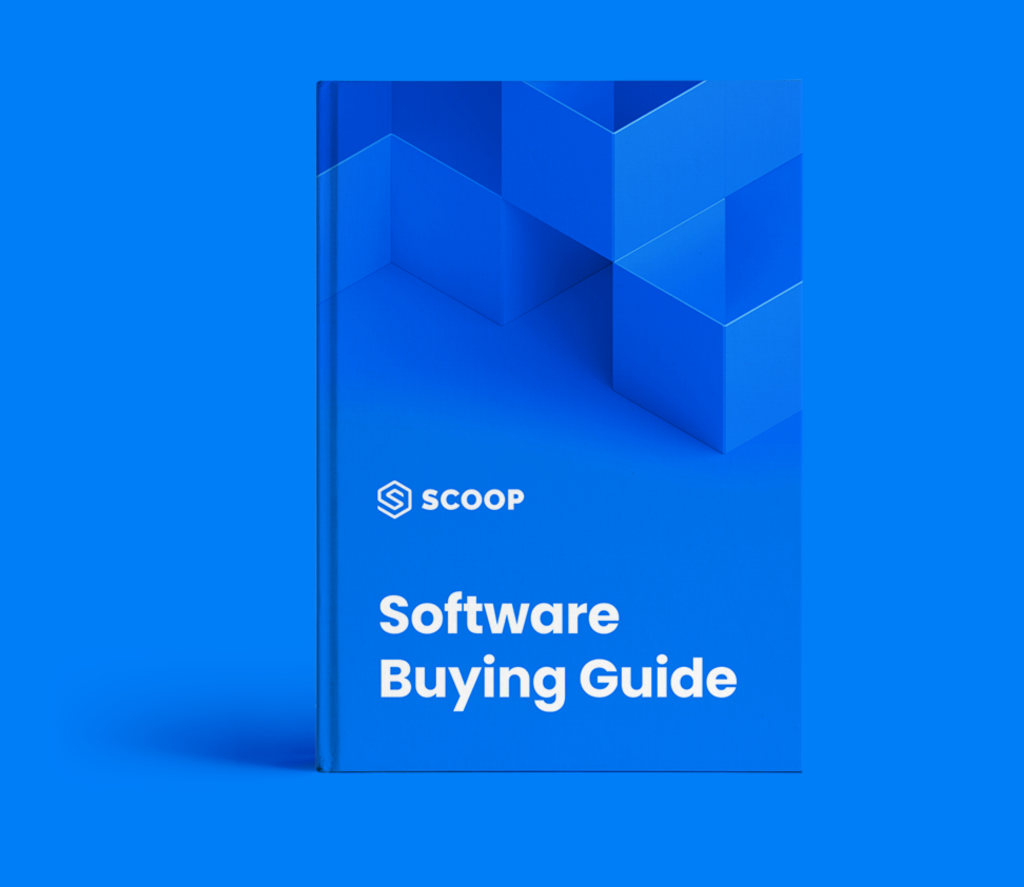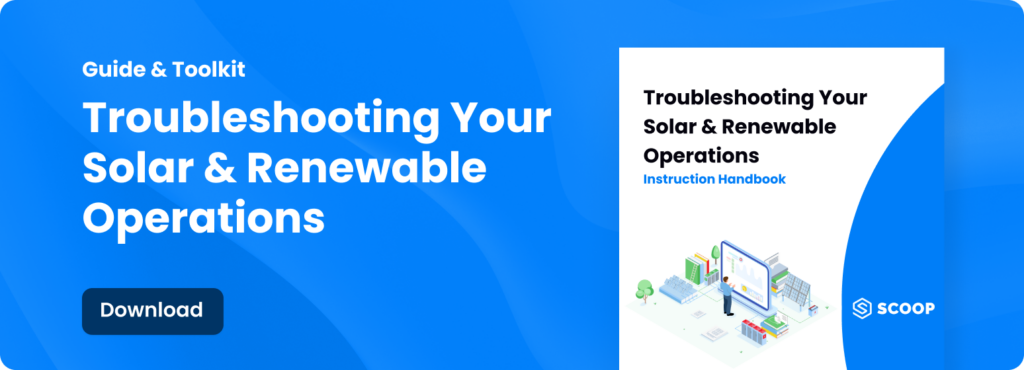Software Buying Guide
for residential solar, renewable or home electrification installers.

Table of Contents
Evaluation Metrics
Impact on Day-to-Day Operations
How the mistake can disrupt your team's daily workflows, affecting productivity, task efficiency, and overall operational smoothness.
Upfront Capital Cost
The initial expenses required to purchase, implement, and integrate the software, including setup fees, training, and any immediate upfront costs.
Long-Term Operating Cost
The ongoing expenses over the lifespan of the software, such as maintenance, support, upgrades, and potential costs related to scaling, such as consulting and development.
Strategic Opportunity Cost
The potential gains or competitive advantages missed by opting for a less effective solution, including lost revenue, lost time, or inability to take on growth opportunities.
Terminology Clarification
To avoid any confusion, we thought it’d be a good idea to set the record straight before we dove into it. When we mention “renewables”, “new energy”, and “home electrification” in the context of residential installations, we refer to anything related to solar, EV chargers, battery storage, HVAC, home energy efficiency, etc. Essentially, any installation that contributes to making homes more environmentally friendly and sustainable. That’s it. Now, let’s get started!
State of the Market
The renewable energy sector—whether solar, EV charging, HVAC, home energy efficiency, battery storage, or others—experiences its share of up and down cycles. While any business may need to endure a degree of cost-cutting and downsizing during slower periods, savvy leaders recognize that these slower periods also present a unique opportunity to build and improve critical operational systems.
Investing in software and automation is one of the most effective ways to ensure your operations are prepared to be that engine for growth. In booming markets, this engine allows you to scale faster than the competition and take on more opportunities; in slower markets, it enhances your team’s efficiency and lets you run lean with the team you have while preserving quality and service levels. This positions your company to be ready for the next wave of growth when the market rebounds. Companies across the board are increasingly turning to technology to lead this shift.
Choosing and rolling out new software may seem simple enough, however it is far from trivial. With so many options out there screaming at you with their features and proclaiming they are the best all-encompassing solution, it can be a daunting task for leaders to decide how to move forward. This decision is made even more serious and stressful given all that rides on it namely, the significant time, effort, and money to be spent and the future performance of your team (no pressure!)
That’s why we’ve put together this guide. We mapped out 12 of the biggest mistakes we’ve seen residential renewable companies make when jumping into meetings with our team. These mistakes are also paired with alternative ways of approaching software selection so that you’re not only aware of what to avoid but also how to do it correctly. In a nutshell, we are here to hopefully take some of the stress and confusion out of the process and equip you with simple practical pointers you can use today!
Software Buying Mistakes
1. Fixating on Finding an All-In-One Software
Impact on Day-to-Day Operations
All-in-one software falls under the old adage of jack of all trades, master of none. Your inability to access game-changing functionality to power specific areas of your business leads to many operational inefficiencies, impacting every team’s productivity and workflows.
Upfront Capital Cost
The (false) promise of covering all your needs in one platform may translate to some reduction in initial costs as you reduce the number of tools that need to be onboarded. This is not always the case since often all-in-one software commands a high sticker price.
Long-Term Operating Cost
As your business grows, you will face expensive overhauls, consulting fees, integration of additional tools, and development costs to compensate for the software’s limitations.
Strategic Opportunity Cost
The limited access to advanced features and innovations hinders your ability to improve operations, increase revenue, and scale your business.
Why It's a Mistake
It’s easy to be drawn in by the allure of an all-in-one software solution, especially when marketed as the ultimate fix for all your business needs. Here’s why you shouldn’t fall for it:
1. All-in-One Doesn’t Really Exist Any Longer (if it ever did): The concept of all-in-one software is a marketing tactic. No single tool can deliver top-tier performance across every function. These solutions often spread themselves too thin, failing to meet the diverse and specialized needs of a growing renewable energy business.
2. Don’t Get Chained to a Single Vendor: As your business scales and grows more complex, these systems struggle to keep up, leaving you stuck with a vendor that no longer meets your needs. With your entire operation relying on a single vendor, transitioning becomes expensive and disruptive to daily operations.
Recommended Approach
Top-performing new energy teams use the best-of-breed approach, meaning they build a tech stack composed of specialized tools connected by a Central Operations Hub (COH):
1. Tap Into Specialized Game-Changing Functionality: Opting for software that excels in specific areas provides highly effective tools tailored to those functions. Unlike “all-in-one solutions” that offer mediocre performance across various areas, specialized tools give every team exactly what they need, enhancing overall efficiency and productivity. With the growth in software capabilities and especially AI, there are increasingly game-changing tools that can make a huge impact on your business - far greater than their incremental cost.
2. A Modular Solution That Grows With Your Needs: Best-in-class tools ensure your business can handle both current and future needs. As the new energy industry evolves, using a tech stack made up of modular specialized tools not only provides you with the best features, but the modular nature of this approach also allows you to swap providers in and out of your tech stack to meet those new needs without breaking the bank or slowing down operations.
“All-in-one is always tempting, but it's not something that I see feasible, especially for the solar industry. That’s why we opted for specialized software that matched our operations and could adapt to our ever-changing needs.”

Sean Palfenier
Director, Riverside Energy Systems
2. Trying to Use General Purpose Software For Core Parts of Renewable Operations
Impact on Day-to-Day Operations
While generic software is useful for peripheral business tasks, it often falls short in managing core renewable operations like installations, commissioning, and service. Lacking specialized features leads to inefficiencies and forces time-consuming customizations. Vendor support teams usually lack expertise in renewable operations, making the process even more challenging.
Upfront Capital Cost
Significant costs arise from using consultants and developers to customize the generic software to meet your renewable-specific business needs.
Long-Term Operating Cost
The upfront costs described above don’t just go away. The ongoing costs of trying to update, customize, and troubleshoot the software’s functionality will simply keep adding up (for little added value).
Strategic Opportunity Cost
You miss out on the potential gains from adopting specialized tools with industry-leading functionalities that better align with your teams’ unique needs.
Why It's a Mistake
It's tempting to use off-the-shelf, generic software to manage your new energy business, but here's why it often leads to failure:
1. New Energy is a Unique Industry with Unique Needs: Renewable businesses are highly distributed, managing complex and varied project needs across both field and office environments. Generic software architecture and workflow simply aren't up for handling the unique challenges you face daily.
2. You'll Waste Countless Hours Customizing Generic Tools: Adapting generic software to fit your specific requirements can consume a massive amount of time and resources, including endless consultant and development hours (and fees). You end up forcing software to do things it was never designed for and therefore takes a lot of tweaking to make work.
3. Not All Parts of Your Business Are Compatible with Generic Software: While sales-related processes may integrate well with a generic CRM (due to their relative simplicity) critical functions like field installation and service operations require tools tailored specifically to the new energy industry. Using generic software for these processes will hinder your efficiency.
Recommended Approach
To ensure optimal performance and a smooth operation, adopt renewable-specific software solutions built for the complexities of your business:
1. Look for Software Specialized in Renewables: Renewable-specific software is developed with your unique needs in mind, minimizing the time and effort spent adapting tools not meant for your business.
2. Tailored Solutions Save Time and Maximize Efficiency: By investing in renewable-specific tools, you avoid the steep learning curve and constant adjustments that come with generic software. These solutions are designed to help you work more efficiently from the start.
3. Work with a Team that Understands New Energy: A specialized software provider that has deep-rooted knowledge of the industry, offering onboarding and customer support in line with the exact needs of your business, ensuring better software usage and minimal interruptions.
"We tried using generic project management software and Google Drive, but it wasn’t designed for our industry’s specific needs. As we grew, it became clear we needed something tailored to solar."
3. Fixating on Legacy Software Categories Such as CRM, ERP, or PM
Impact on Day-to-Day Operations
In essence, this is akin to taking the lazy approach of going with what you know rather than doing the research to find new technology that could give you an edge. Fixating on legacy software categories such as CRM, ERP, or PM especially as your all-in-one solution can result in overlooking key needs, leaving gaps in your daily operations and limiting efficiency in critical, industry-specific areas.
Upfront Capital Cost
Be very careful when going for one of these types of software as your singular solution. Not only do they likely only partially cover your needs, but they also come with a hefty initial price tag.
Long-Term Operating Cost
Additional development and consulting costs arise as you try to customize or integrate multiple tools to cover the missing functionality.
Strategic Opportunity Cost
Sticking to familiar software categories could prevent you from implementing more tailored solutions that would better optimize your business and which your competitors are likely adopting.
Why It's a Mistake
New energy companies often gravitate toward popular software categories, but this narrow focus can lead to missed opportunities:
1. Many Renewable Companies Default to CRM, ERP, or PM Software: These tools are well-known and have been around for a while, so it’s natural to assume they are everything a company needs to run operations. However, just because they are familiar doesn’t mean they will address all the specific challenges your business faces.
2. These Tools Are Often Not the Whole Solution: While CRM, ERP, or PM software might address some aspects of your business, they are rarely comprehensive enough to meet all your needs—despite what vendors may claim in their sales pitch. Relying on them alone can leave critical gaps in your operations.
Recommended Approach
Instead of fixating on the most popular software categories, take the time to explore tools that are tailored to your needs:
1. Research Beyond Traditional Categories: The tools that will truly solve your new energy business challenges may not fall into the categories you expect - or more than likely require combining functions from multiple tools including these categories. Keep an open mind and investigate options beyond the typical CRM, ERP, and PM systems.
2. Discover Unique Software Solutions for Your Industry: By definition, there are lesser-known, niche tools specifically designed for the renewable industry that could be critical parts of your overall solution. Invest the time to explore these options—doing so will ensure you’re equipped with software that genuinely supports your business needs.
"Netsuite worked extremely well for inventory management and finance, but no matter how much effort we put into making it meet our project management needs, it fell short."

Beth Holaday
Operations Manager,
Verde Energy Efficiency Experts
4. Overlooking the Role of Robust Software Integrations
Impact on Day-to-Day Operations
Once you agree that your business needs the combined functionality of a handful of best-of-breed tools, it’s important to realize that the success of managing multiple software platforms rests squarely on the quality and robustness of integrations. In other words, it’s not enough to just sign up for a few software tools and take their off-the-shelf integrations that only do a fraction of the workflow and dataflow coordination your business needs.
Upfront Capital Cost
Off-the-shelf or zap type integrations are often included or inexpensive so upfront costs will inevitably be lower than a custom-configured integration.
Long-Term Operating Cost
Superficial or missing workflow or dataflow automation software will result in a need for more staff to handle the increased number of manual steps and data entry between your platforms.
Strategic Opportunity Cost
Missed opportunities arise as you are unable to create a seamless, technology-driven operational system that enhances team collaboration and supports growth.
Why It's a Mistake
Many businesses mistakenly view their software stack as isolated, stand-alone tools, leading to inefficiencies and higher costs:
1. Seeing Software as Siloed, Independent Tools: Treating each software solution as a separate entity prevents them from working together effectively. Over time, you’ll accumulate so many different tools with mismatched data that managing your operations will feel as chaotic and unorganized as using spreadsheets—only much more expensive.
2. Thinking That Off-The-Shelf Integrations Will be Enough: You visit a software's website and see a list of logos from other tools it's integrated with. That should solve your problem, right? Unfortunately, integrations between tools can be much more complicated than they appear. How well they work depends heavily on how each business’ specific workflows and data needs.
3. It’s Like a Conductor Leading One Instrument at a Time: Imagine trying to lead an orchestra but only being able to communicate with one musician at a time. The result would be a disjointed performance. Similarly, software that doesn’t integrate well leaves your business struggling to operate in harmony.
Recommended Approach
To maximize efficiency, focus on integrating your software to create a cohesive system that works together seamlessly:
1. Your Software Stack is an Ecosystem: Instead of thinking of your tools as independent, consider how they can be interconnected to form a system that is greater than the sum of its parts. A well-integrated software ecosystem will allow you to streamline your operations and maximize productivity.
2. Ensure Smooth Workflows and Automation: Think through your workflows and data management. The goal should be to run projects seamlessly and automate routine tasks so you can focus on running and growing your business—not getting bogged down by manual processes.
3. It’s Like a Conductor Leading an Entire Symphony: When your software works together, it’s like a conductor being able to communicate with the entire orchestra at once, creating a harmonious symphony.
4. Deploy a Central Operations Hub (COH) for Seamless Coordination: If you’re serious about growth and maximizing your use of integrated best-of-breed systems, deploy a Central Operations Hub (COH) to coordinate your tech stack. A COH (such as Scoop®) ensures the seamless coordination of workflows, dataflows, and user experience across different platforms, providing a single source of truth in your entire operations. The robust (and configurable) integration engine within a COH also allows you to tailor the workflows and dataflows to your needs.
"Companies are increasingly waking up to the power that a best-in-class tech stack can bring them. What is less obvious is how to make this actually work. This is where having a robust COH and configurable integrations really make a difference."

Babak Sardary
CEO, Scoop
5. Selecting Software Based on Price Tag Instead of Impact & Value
Impact on Day-to-Day Operations
Cheap software often lacks essential features and reliable performance that provide actual value to your operations—look for the return on investment, not price.
Upfront Capital Cost
On the surface, some software tools may be cheaper; that’s just a fact. However, keep in mind that the subscription only represents the tip of the cost iceberg—many other factors come into the overall costs that are often more subtle and not discovered until later.
Long-Term Operating Cost
Higher expenses from frequent maintenance, upgrades, and additional support needs, as well as costs associated with reduced functionality and productivity.
Strategic Opportunity Cost
This leads to missed opportunities for growth and efficiency gains, as more expensive, higher-quality solutions can deliver greater value and support business development.
Why It's a Mistake
Choosing software solely based on price can lead to hidden costs and missed opportunities for growth:
1. Low Price Tags Can Be Misleading: While it’s tempting to opt for cheaper software solutions, creating quality software requires significant resources. Vendors offering rock-bottom prices often cut corners, resulting in low-value products that don’t meet your needs.
2. Cheap Software Often Lacks Long-Term Value: Vendors that focus on being a low-cost provider are much less likely (or able) to invest in innovation, research and development, or robust support. Over time, the limitations of these budget solutions can hinder your business, leading to wasted time and money, as well as missed opportunities for growth and efficiency.
3. Opportunity Costs Add Up and Limit Your Success: The cost of the software is only one part of the overall cost. In addition to that companies are in fact investing significant effort and cost of implementing the software, training your team, and gaining adoption. Therefore you’d want this significant investment to be with a software tool that is resilient into the future. By focusing on just the subscription price tag, you’re missing out on the opportunity to use a more powerful tool that could significantly improve your operations, providing a far superior ROI (because, yes, software is the engine of your growth and therefore should be viewed as one of the most important investments you make).
Recommended Approach
Shift your mindset from focusing on price to seeing software as a long-term investment in your business’s success:
1. See It as an Investment—Think Long Term:When evaluating software, consider not just the price but the impact it will have on your business down the road. How will this tool improve efficiency, scalability, and your ability to manage projects? Think of yourself in the future and what you’ll need to grow.
2. Consider the Return on Investment: Even if a solution costs more than anticipated, think about the potential ROI. A more expensive, best-in-class software might lead to faster project completion, improved team collaboration, and the ability to manage more work—delivering greater value over time. The added cost may be a small fraction of the returns.
3. Pay Mind to the Team and the Roadmap: Look at the team you are partnering with and their passion, outlook, industry knowledge, and roadmap. After all, you are not just signing up for a piece of technology but getting into a relationship with a partner. These factors make a world of difference when you fast-forward only a few years.
"Opting for cheaper software may seem like a saving, but ultimately, it just hinders growth and productivity and leaves you wishing you had invested in a proper system sooner."

Sean Palfenier
Director, Riverside Energy Systems
6. Failing To Involve & Educate Your Team
Impact on Day-to-Day Operations
Achieving success with your new solution could be hindered by two intertwined challenges: pushback from your team, whose input was ignored and education overlooked, as well as a system that falls short of meeting their needs.
Upfront Capital Cost
While the selection process might be faster, implementation will take significantly more time and resources due to misalignment between the platform and your teams’ needs.
Long-Term Operating Cost
The mismatch between software and team needs can result in wasted resources and additional costs for further customization, training, or even a replacement system.
Strategic Opportunity Cost
While this can be fixed over time, not involving your team means missing out on valuable insights that could have led to more effective platform use, increasing your ability to improve operations quickly.
Why It's a Mistake
Ignoring your team during software selection and implementation can cause unnecessary friction and lead to difficult and limited adoption:
1. Your Management Team is Too Far Removed: The people using the tools daily are the ones who truly understand what’s helpful. Managers and executives may be too far removed from the day-to-day to make the best decisions on their own.
2. Lack of Team Input Equals Wasted Resources: While you can try to get buy-in after the fact, not involving your team from the start leads to resistance and, in turn, wasted time, money, and frustration.
3. Your Team Needs to Understand The Why: If your team doesn’t understand why the change is happening, they’ll see it as an inconvenience or even a threat. Without proper context, resistance to change grows.
Recommended Approach
Engaging your team from the start ensures alignment throughout the organization and leads to quicker implementation and better software usage:
1. Ask for Feedback & Involve Everyone: Bring your team into meetings to gather feedback and map out what different departments need. This input will help ensure the tools meet their real needs, making the transition much smoother. People are much less resistant when they feel heard and involved in the process.
2. Show How It Benefits Them: Spell out exactly how the new software can make their jobs easier: simplifying daily tasks, reducing manual work, freeing up more time for client interactions, and allowing them to learn new tech skills. When they see the personal rewards, they’ll be much more likely to embrace the change.
"We brought everyone in the company together and mapped out our entire installation process. This forced us to be honest with each other and talk about what works and, most importantly, what doesn’t. Going through this process is truly what allowed us to find quick and sustainable success with our new software"

Rachel Levey
Inside Sales & Service Coordinator, PV Squared
7. Looking for Point Solutions Rather Than an Engine For Growth
Impact on Day-to-Day Operations
Focusing on point solutions to solve only specific problems can lead to a build-up of clusters of disparate tools, preventing your team from achieving a connected technology stack.
Upfront Capital Cost
Upfront costs are lower because the quick and limited implementation of the software minimizes initial expenses and speeds up the process.
Long-Term Operating Cost
This approach results in ongoing and costly operational inefficiencies and a continual cycle of seeking new solutions due to the underutilization of existing tools.
Strategic Opportunity Cost
By not choosing software that scales with your business, you miss out on the chance to streamline operations and support sustained growth, ultimately limiting your competitive edge and market responsiveness.
Why It's a Mistake
Relying on short-term fixes in software selection can significantly hinder your company’s capacity for growth and adaptability:
1. Patching Means Constantly Playing Catch-Up: Many businesses focus on solving a current issue without thinking about future challenges. When you patch problems with point solutions, you’re always just one step behind. As your business evolves, new problems will emerge that these piecemeal solutions won’t be able to handle.
2. Software Isn't "Set It and Forget It": Treating software like an appliance you set and forget means you’ll end up with a system that doesn’t adapt to your changing needs or is underutilized, limiting your growth potential.
Recommended Approach
Develop a software strategy that not only resolves current issues but also anticipates future needs, enhancing your capacity for growth and innovation:
1. Think Beyond Your Current Issues: Instead of just fixing today’s problem, look for a solution that can scale as your business grows. Just as you plan for your company's future, your software strategy needs to be forward-thinking. Invest in solutions that can evolve with your business and help you stay ahead of the curve.
2. See Your Software as an Engine for Growth: Having the right technology today is not just about solving individual problems—it’s about creating a fully connected best-of-breed technology stack that can serve as your foundation for growth. Embrace a mindset where technology helps you diversify revenue streams, expand services, and build a culture that views tech as essential for staying ahead, not just a band-aid solution.
"One of the biggest mistakes we’ve seen companies make is treating software as a quick fix to a single problem, like buying an appliance that you just turn on and forget about—it eventually fails because it was never integrated into the company’s long-term strategy."

Babak Sardary
CEO, Scoop
8. Overlooking the Importance of Quality Onboarding & Support
Impact on Day-to-Day Operations
Poor onboarding hinders your team’s ability to effectively utilize new software, leading to operational delays, user frustration, and potential failure to implement the software—trust us, this happens more often than you think.
Upfront Capital Cost
Initial expenses are higher due to prolonged onboarding, delaying the platform’s benefits and extending the time before you can fully utilize its features.
Long-Term Operating Cost
Inadequate onboarding leads to suboptimal use of the platform, whereas poor ongoing support creates continual frustration and operational downtime, affecting project execution.
Strategic Opportunity Cost
A lack of effective onboarding and quality support can prevent your team from fully leveraging the software’s capabilities, thus missing out on potential operational efficiencies and growth opportunities.
Why It's a Mistake
Finding the right software solution is just the beginning. Without proper onboarding and support, even the best software can fail to deliver value:
1. Onboarding Can Make or Break Your Software Adoption: Securing a great solution is important, but without a well-thought-out onboarding process, your team won’t know how to use it effectively. This leads to wasted time, frustration, and even complete failure to adopt and deploy the software altogether.
2. Technical Difficulties Will Happen, Make Sure You're Supported: No technology is flawless. When issues arise, the impact on daily operations can be significant. The last thing you want is to have the operation come to a halt as you wait for support or try to explain the situation to someone with little to no knowledge about your industry.
Recommended Approach
Prioritize quality onboarding and customer support when choosing software—the last thing you need is an untrained team and to be left alone when things go sideways:
1. Consider The Onboarding Process as a Key Factor: Ensure the software provider offers a structured, hands-on onboarding process. This will help your team quickly adopt and make the most of the new system, reducing frustration and speeding up your time to value.
2. Customer Service Shapes Your Experience & Satisfaction: Technical issues are inevitable. Knowing you can rely on real people who care about helping your business succeed and have deep-rooted renewable energy knowledge makes all the difference. Reliable assistance during technical issues minimizes downtime and helps keep your operations running smoothly.
"Thanks to world-class onboarding and continuous support, we feel empowered to not only tackle any issues without hesitation but also use the platform to its full capacity."

Beth Holaday
Operations Manager, Verde Energy Efficiency Experts
9. Wanting to Configure the Perfect Solution Immediately & All At Once & Support
Impact on Day-to-Day Operations
Trying to implement a complex solution fully loaded with features right away creates a steep implementation and learning curve for your team, causing delays and reducing efficiency as they struggle to adapt.
Upfront Capital Cost
Involves a resource-intensive implementation phase, requiring extensive training, customization, and integration efforts, which significantly increase the time and money necessary to make it work.
Long-Term Operating Cost
This leads to adoption failure if the solution is too complex, requiring further time and investment to simplify or replace. It can also delay the potential returns you might have gained from a simpler, phased rollout.
Strategic Opportunity Cost
Focusing on finding a perfect solution makes you vulnerable to overly ambitious sales pitches and may cause you to miss out on more practical solutions that could start addressing your highest-priority needs sooner and allow for scalable upgrades.
Why It's a Mistake
Digitizing and automating your entire business doesn’t happen overnight. Let’s say that your search has come to a conclusion and you have found a powerful solution with lots of flexibility and configurability. You’ll want to resist the temptation of trying to build the perfect solution and utilize every feature immediately, as this can lead to unnecessary setbacks:
1. Steep Implementation and Learning Curve When Trying to Utilize All The Bells & Whistles: Wanting to use all of a software’s features from the start can overwhelm your team, creating a steep learning curve and delaying the benefits that the tool could bring. Instead of optimizing efficiency, it may slow progress as your team struggles to adapt.
2. Over-Optimization and Gold-Plating: Trying to perfect a part of your solution before getting a practical first version into the hands of your team is a classic mistake. Often such polishing ends up being a wasted effort later when you learn from users what really matters to them.
3. Risk of Losing Executive / Organizational Support: Everything in life has a shelf life. Things change and priorities shift. If as a leader and change agent today you have the support of your team to implement a solution, you want to get to results as quickly as possible. Waiting to perfect your solution to be flawless is going to significantly lengthen the time-to-demonstrated value. In this period your initiative is vulnerable to changing priorities and resources.
Recommended Approach
Instead of trying to implement everything at once, focus on addressing key pain points first by adopting modular solutions connected through a central operations hub like Scoop:
1. Start Small and Add Product Features Gradually: By prioritizing your most urgent needs, you can introduce key functionalities that address them. Then, once your team is comfortable and you’ve seen improvements, you can add on other non-core features that will help bring your business to the next level.
2. Manage Change More Effectively & Ensure Adoption: A phased approach gives your team the time they need to adapt to each new functionality, making the overall transformation more manageable and less overwhelming. Over time, it leads to greater long-term success and ensures they don’t just reject the new system and revert to old habits.
"At first, I wanted to implement as many features as possible but we quickly realized that, in the beginning, simpler is better."

John McNamara
COO,
Appalachian Renewable Power
10. Not Considering the Needs of Your Field Team
Impact on Day-to-Day Operations
Software that neglects field team requirements results in disjointed workflows and dataflows, hindering the effectiveness of your operations and creating significant operational gaps between field and office teams.
Upfront Capital Cost
Overlooking field-specific requirements often leads to adopting additional, non-integrated point solution apps to fill these gaps—adding to the complexity and cost of your software infrastructure.
Long-Term Operating Cost
Using separate, uncoordinated systems increases long-term operational costs due to inefficiencies in data handling and the need for manual data entry, leading to a higher likelihood of errors and delays.
Strategic Opportunity Cost
Failing to provide integrated solutions for your field team limits their efficiency and responsiveness, affecting overall business performance and missing out on opportunities for streamlined, error-free field operations.
Why It's a Mistake
Forgetting to empower your field team when selecting software can cause major disruptions in your business operations:
1. Your Operation Will Be Disconnected: Solar and new energy work is highly distributed and field-oriented. Many tools focus solely on office-based tasks, ignoring the unique needs of field teams. This creates a gap in workflow and data flow, which can significantly limit the effectiveness of even the best office solutions.
2. Non-Integrated Apps Add Costs and Inefficiency: When you overlook the needs of field teams, you often end up adding separate, non-integrated point solution apps. Not only does this increase costs, but it also forces the field team to transfer data manually, such as photos, between systems—adding unnecessary steps and creating opportunities for errors and delays.
Recommended Approach
To ensure seamless operations between field and office teams it’s important to select tools that provide a unified experience for both:
1. Equip Both Field & Office Teams With Powerful Tech: Look for software solutions that offer a streamlined user experience and connect office and field teams. By using the same integrated database, both teams can access and update the same data in real-time, ensuring accuracy and efficiency.
2. Create Tailored Views for Field Teams: A good solution allows field teams to only see what’s relevant to them without the clutter. This clear, focused interface helps them know exactly what tasks they need to complete—improving productivity and reducing costly errors.
"The fact that Scoop was developed with both the needs of field and office teams in mind has helped us solve A LOT of our problems."

Beth Holaday
Operations Manager, Verde Energy Experts
11. Forgetting Your Partners & Subcontractors
Impact on Day-to-Day Operations
Selecting software that ignores the integration needs of subcontractors and partners leads to coordination challenges, resulting in workflow bottlenecks, delays, and potential miscommunications that affect project execution.
Upfront Capital Cost
Initial costs are lower, particularly with software that features per-user pricing models, as you may only pay for the core team initially, excluding subcontractors.
Long-Term Operating Cost
Over time, inefficiencies in work assignments and data exchange can accumulate, leading to higher costs from delays and the need for additional tools or personnel to bridge the gaps.
Strategic Opportunity Cost
Hampers your ability to scale and take on more projects efficiently, as subcontractors are crucial to expanding new product offerings and markets.
Why It's a Mistake
Forgetting to consider your partners and subcontractors in your software selection can create significant inefficiencies in your business operations:
1. Your In-House Teams Aren't The Only Ones Who Need Proper Technology: Choosing software that only serves your in-house team leads to challenges in assigning work to subcontractors and exchanging data with them. Many renewable energy companies rely heavily on subcontractors and partners to help balance workloads, making it essential that they fit seamlessly into your processes. If you don’t integrate them in your tech stack, manual workarounds can create bottlenecks, delays, and miscommunication, affecting overall project efficiency.
Recommended Approach
To ensure seamless operations between field and office teams it’s important to select tools that provide a unified experience for both:
1. Assemble a Unified Virtual Team: Look for software that allows you to bring your in-house staff and subcontractors together into one virtual platform—enabling you to manage tasks and communication seamlessly, reducing inefficiencies in project execution.
2. Flexible Access Controls with Unlimited Users: Opt for tools featuring an unlimited user pricing model and flexible access controls. Ensuring you can easily add partners and subcontractors as users while controlling which jobs and data they can access, streamlining the collaboration process without compromising security.
3. Mastering How to Build & Operate Virtual Teams Can be a Huge Competitive Advantage: As an organization, you can scale your business a lot faster to multiple territories if you are able to tap into partner and subcontractor resources in a scalable and reliable fashion. The right software can help you do this with proper oversight and access control.
"Providing subcontractors with real-time access to the key project information has been a game-changer, allowing them to complete their work more efficiently and cutting down on costly delays."

Erin McGaun
Director of Operations,
Lumina Solar
12. Overlooking the Importance of User Friendliness & User Experience
Impact on Day-to-Day Operations
Complex software is hard to use for everyday workflows and requires specific technical expertise to modify, making it challenging for teams to swiftly adapt to changing operational requirements or experiment with new processes.
Upfront Capital Cost
The cost of acquiring and integrating a feature-heavy system is typically higher due to its complexity and the associated need for specialized training.
Long-Term Operating Cost
Ongoing costs can escalate from the need for continuous support and development adjustments, often requiring external expertise to manage and modify the system.
Strategic Opportunity Cost
Limited flexibility due to a complex system hinders quick adaptations and responses to evolving business needs, reducing the company’s overall adaptability and growth potential.
Why It's a Mistake
While having powerful software is important, overlooking user-friendliness and the overall user experience can hinder your business:
1. Complexity For Your Administrator & Reliance on External Development Teams: Many powerful software come with complexities that require coding or technical skills, which most people in charge of managing and configuring the software in new energy companies don’t have. When software requires technical expertise to make adjustments, your admin depends on the provider’s development team to implement changes. This reliance can slow down innovation and responsiveness, leaving your business less agile with fewer people on your team able to configure the platform themselves.
2. Substantial Burden for All Day-to-Day Users: Your software administrator isn’t the only one who is going to feel the weight of the software’s complexit—day-to-day users will also struggle. When routine tasks become cumbersome, it not only slows down operations but also frustrates users. This frustration can quickly lead to resistance, with users avoiding the tool or finding inefficient workarounds to complete their tasks. As a result, adoption rates drop, and the software becomes underutilized, limiting its potential to drive efficiency.
Recommended Approach
IIt’s essential to balance the power/sophistication of a solution with user-friendliness to get the most out of your software:
1. Empower More Users Across the Organization: Ensure that the software you choose is not only powerful but also user-friendly. This will allow multiple team members to make necessary adjustments, enabling a more dynamic and flexible work environment without requiring specialized technical skills.
2. Foster Continuous Improvement and Agility: When software is easy to configure, it promotes a culture of continuous improvement, allowing your organization to quickly adapt and refine processes—helping your team stay competitive in a rapidly evolving market.
"A powerful tool is great, but if it's too complex for the whole team to understand and adapt as needs evolve, it can quickly become a burden rather than a solution."

Beth Holaday
Operations Manager, Verde Energy Efficiency Experts
Conclusion
Navigating the industry's inevitable cycles requires strategic foresight and resilience. While economic downturns may compel businesses to tighten their belts, these periods also offer a critical opportunity to invest in and refine your operational systems. By prioritizing software and automation, companies can build a robust engine for growth that not only enables rapid scaling during market booms but also ensures survival during slower times.
As you embark on this journey, choosing the right technology is key. Avoid common pitfalls by following the 12 tips outlined in this guide, and you’ll be well-equipped to lead your company through any market cycle with confidence. Scoop's Central Operation Hub (COH) can be a central part of that growth—allowing you to sidestep these challenges.
Reach out to our team to learn more about how we can help you build the future of renewable energy.
